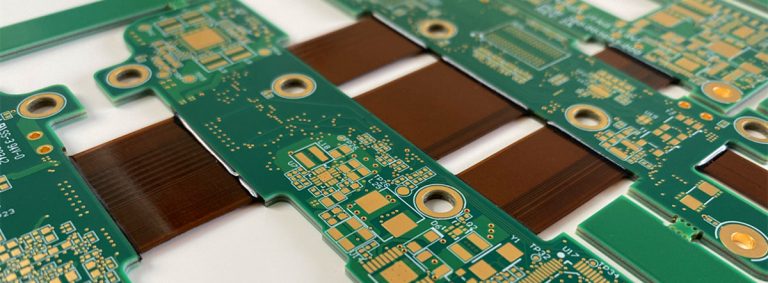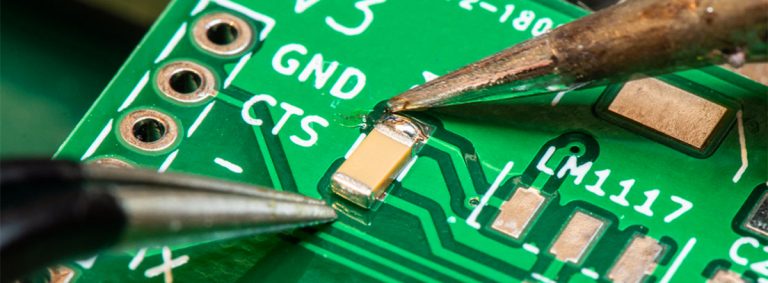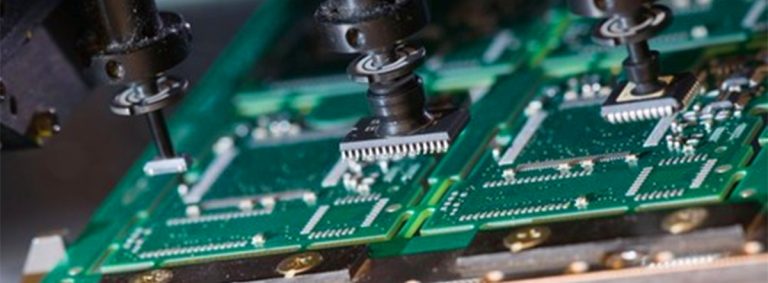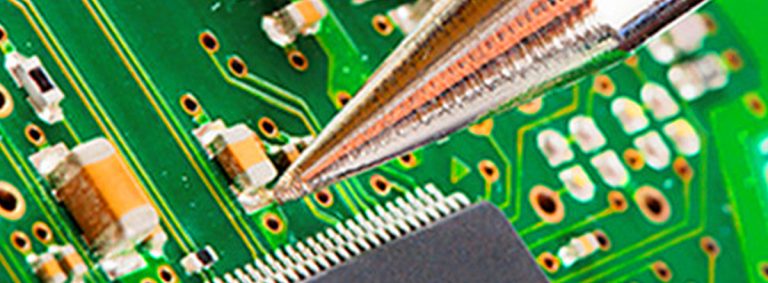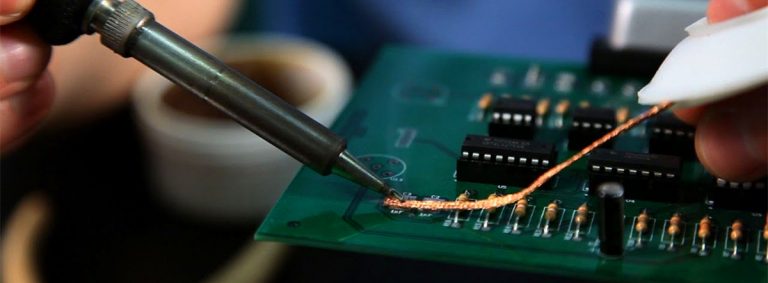8 Focus on High Tg FR4 PCBs Unleash Thermal Resilience
High Tg FR4 PCBs material stands at the forefront of modern printed circuit board technology, Which steps in as a versatile and advanced solution offering enhanced thermal stability and reliability in demanding electronic applications. As electronic devices become more sophisticated and compact, the need for PCBs manufacturing that can withstand higher operating temperatures and challenging environments becomes paramount.
High-Tg, which denotes “Glass Transition Temperature,” plays a pivotal role in defining the material’s capability to withstand elevated temperatures without compromise. This introduction delves into the significance of High-Tg FR4 PCB material in addressing the challenges posed by high-frequency PCB designs, the power electronics PCB, Aluminum PCB for LED lighting modules, and the automation-driven landscape of PCB manufacturing.
Definition of High Tg FR4 PCB
FR4, short for Flame Retardant 4, is a widely used type of epoxy-based fiberglass material that serves as the substrate for many printed circuit boards (PCBs). It’s one of the most common and cost-effective choices for PCB fabrication due to its desirable electrical, thermal, and mechanical properties.
High-Tg, which stands for “Glass Transition Temperature,” is a critical parameter that signifies the temperature at which the PCB material transitions from a rigid state to a more flexible, rubber-like state. In the context of PCBs, a higher Tg indicates that the material can withstand elevated temperatures without undergoing undesirable physical or electrical changes. High-Tg FR4 material is engineered to have a significantly higher Tg compared to standard FR4, making it an excellent choice for applications where elevated temperatures are a concern.
What is the temperature about normal FR4 PCB VS High Tg FR4 PCB?
Normal FR4 PCBs:
The standard FR4 PCB material has a Glass Transition Temperature (Tg) typically around 130-140°C. Operating Temperature Range: Approximately -40°C to 130°C, This means that the material starts to transition from a solid to a more flexible state around this temperature. Below the Tg, the material remains relatively rigid, while above the Tg, it becomes more flexible and susceptible to mechanical changes.
Normal FR4 PCBs are commonly used for a wide range of electronic devices that operate under standard temperature conditions and moderate environmental stresses. Know more about FR4 PCBs, please click this article about Exploring the World of FR4 PCBs
Medium Tg PCBs:
Glass Transition Temperature (Tg): Usually between 150°C and 170°C, Operating Temperature Range: Typically around -40°C to 150°C or slightly higher, Medium-Tg PCBs offer an intermediate level of thermal stability between normal FR4 and High Tg PCBs. They are often chosen for applications where higher temperatures are expected but not extreme.
High Tg PCBs:
High Tg PCBs are designed to withstand higher temperatures than standard FR4 materials. which have a Glass Transition Temperature that is significantly higher, often around 170°C or more. Operating Temperature Range: Generally around -40°C to 170°C or highe ,This enhanced Tg value allows the material to maintain its structural integrity and electrical properties at elevated temperatures.
High-Tg FR4 PCBs are designed for applications that require enhanced thermal performance. They can withstand elevated temperatures and maintain their structural and electrical integrity. High-Tg PCBs are commonly used in industries such as automotive, aerospace, industrial equipment, and high-power electronics.
Thermal Stress and Stability for High Tg FR4 PCBs
- Enhanced Thermal Resilience
- Reduced Warping
- Reliable Solder Joints
- Consistent Electrical Performance
- Longevity in Harsh Environments
- Reliability in High-Power Electronics
- Mitigation of Thermo-Mechanical Stress
- Resistance to Thermal Fatigue
- Consistency in High-Temperature Environments
- Design Freedom in Elevated Temperatures
- Robustness in Automated Manufacturing
- Consistent Performance Over Time
Significance of High Tg FR4 in PCBs:
In applications requiring high-frequency PCB designs, maintaining signal integrity is paramount. High Tg FR4 material ensures that the substrate can handle the increased demands of high-frequency signals without introducing signal loss or distortion due to temperature-related variations.
Additionally, power electronic PCBs, which encounter substantial heat generation, benefit from the material’s resilience against thermal stress. The same holds true for LED PCBs, where efficient thermal dissipation is essential for optimal performance and longevity. These are lists for Significance of High-Tg in PCB
- Enhanced Thermal Reliability
- Consistent Mechanical Properties:
- Consistent Mechanical Properties:
- Improved Dielectric Properties
- Extended Operating Temperature Range
- Reliability in Harsh Environments
- Minimized Thermal Expansion
- Durability in Manufacturing Processes
- Long-Term Performance
- Compatibility with High-Power Electronics
- esign Flexibility
- Support for Advanced Applications
Design Considerations for High Tg FR4 PCBs
Designing with High-Tg (Glass Transition Temperature) FR4 PCB material introduces a range of considerations that leverage its enhanced thermal stability and mechanical integrity. These considerations ensure optimal performance, reliability, and manufacturability of the PCBs in applications demanding higher operating temperatures and challenging environments.
Trace Width and Spacing:
High-Tg FR4 materials can endure higher temperatures without affecting their structural integrity. This allows for tighter trace widths and spacing, enabling more compact designs without compromising signal integrity.
Via Design and Placement:
When planning vias, consider their size, aspect ratio, and distribution. High-Tg materials provide better heat dissipation, making them suitable for designs involving thermal vias that help manage heat.
Component Placement:
Optimize component placement to evenly distribute heat-generating components across the PCB. This minimizes localized hotspots and ensures efficient heat dissipation.
Thermal Management Solutions:
Utilize thermal relief patterns, heat sinks, and copper pours to manage heat effectively. High Tg FR4 PCBs materials can better handle thermal stress, enabling improved thermal management strategies.
Impedance Control:
High-Tg FR4 materials maintain their dielectric properties at elevated temperatures, making them suitable for high-frequency applications. Precise impedance control becomes essential for maintaining signal integrity.
Copper Weight and Thickness:
Consider using heavier copper weights for increased current-carrying capacity. The material’s enhanced thermal stability accommodates the higher temperatures generated by higher current loads.
PCB Layer Stackup:
Design a well-balanced layer stackup to achieve controlled impedance, minimize signal loss, and manage thermal stress. High-Tg FR4’s improved dimensional stability aids in maintaining stackup integrity.
Board Size and Shape:
High-Tg FR4 material’s stability under thermal stress allows for larger board sizes and unique shapes. However, ensure that thermal expansion differences are managed across the board.
Pads and Land Patterns:
Adequate pad size and design are crucial for efficient heat transfer during soldering. High-Tg materials maintain pad integrity during reflow soldering processes.
Manufacturability:
Collaborate with your PCB manufacturer to ensure that the chosen High-Tg FR4 material is compatible with their processes. The higher processing temperatures associated with High-Tg materials may require adjustments.
Testing and Validation:
Rigorous testing and simulation are essential to verify the PCB’s thermal performance and structural integrity under different temperature scenarios.
Consideration of High-Temperature Components:
High-Tg PCBs are often used in applications with components rated for higher temperatures. Ensure compatibility between the material, components, and the intended operating temperature range.
Applications of High Tg FR4 PCBs
Their ability to withstand higher temperatures makes them invaluable in a range of applications that demand reliability, longevity, and consistent performance, even in challenging environments.
Automotive Electronics: High-Tg PCBs are well-suited for automotive electronics, where temperature fluctuations within engine compartments and harsh external conditions are common. These PCBs ensure that critical automotive systems like engine control units, infotainment systems, and safety features maintain optimal functionality.
Aerospace and Defense Systems: Aerospace and defense electronics operate in extreme temperature variations, from high altitudes to deep space. These kind of PCBs provide the stability needed to endure these conditions, making them ideal for avionics, satellites, and missile systems.
Industrial Equipment: Manufacturing environments, industrial machinery, and control systems generate heat and require electronics that can withstand continuous operation under high temperatures. They can ensure that these systems perform reliably and have extended lifecycles.
High-Power Electronics: Power electronics generate substantial heat due to high current loads. enhanced thermal stability makes them a preferred choice for power converters, motor drives, inverters, and renewable energy systems.
High-Power Electronics: LED lighting modules often experience temperature variations that can impact their performance and longevity. It plays an important role in helping manage heat effectively, ensuring consistent brightness and reliability over the lifetime of the LED module.
Telecommunications Equipment: Telecommunications infrastructure, including base stations and networking equipment, can encounter high temperatures, guarantee stable performance in the face of temperature fluctuations, contributing to reliable communication networks.
Oil and Gas Electronics: The oil and gas industry operates in extreme environments, including offshore platforms and remote drilling sites. They are well-suited for sensor control, data logging, and monitoring systems in these harsh conditions.
Medical Devices: Medical devices such as diagnostic equipment, imaging systems, and patient monitors can experience temperature variations in clinical settings, ensure consistent operation and data accuracy.
Medical Devices: Even in consumer electronics applications, Laptops, smartphones, and tablets often generate heat during intensive use. These PCBs contribute to the durability and reliability of these devices.
Renewable Energy Systems: In solar inverters and wind power systems, they support efficient power conversion and distribution in environments with varying temperature conditions.
Electronic Testing and Measurement Instruments: Test and measurement equipment used in laboratories and industrial settings benefit from their stable performance, especially when subjected to calibration and testing at different temperatures.
High-Performance Computing: Servers, data centers, and computing systems that run intensive tasks generate heat. High Tg FR4 PCBs ensure that the thermal stress induced by these high-performance operations is managed effectively.
Which PCB material belongs to high TG FR4?
several PCB material brands offer High-Tg (Glass Transition Temperature) materials to meet various temperature and performance requirements. The price of this high TG plate will be higher than that of ordinary TG plate, compare to the PCB manufacturing costs, but its performance and quality are indeed worth the investment in production. Here are some well-known PCB material brands that provide High-Tg options.
Isola Group: Isola offers a range of High-Tg electronic materials suitable for various applications, including automotive, aerospace, and high-power electronics.
Rogers Corporation: Rogers produces High-Tg laminates such as RO4000® series for high-frequency applications and TMM® series for general high-performance needs.
Shengyi Technology: Shengyi provides High Tg PCBs materials known for their stability at elevated temperatures, suitable for applications like automotive electronics and high-power systems.
Panasonic Electronic Materials: Panasonic provides High-Tg materials like Megtron 6 for high-speed PCB and high-frequency PCB designs.
Nanya Technology Corporation: Nanya offers High-Tg materials designed for advanced PCB applications and High-frequency circuit board.
ITEQ Corporation: ITEQ offers a range of High-Tg and high-performance laminates for diverse industries and applications
Arlon Electronic Materials: Arlon specializes in advanced laminates, including High-Tg materials like AD255C04.
Types of High TG FR4 PCBs material
Standard High-Tg FR4: This is a general-purpose High-Tg material with a Glass Transition Temperature (Tg) above the typical range for standard FR4. It provides improved thermal stability and mechanical strength for a wide range of applications.
Lead-Free High Tg: This type is specifically designed for lead-free soldering processes. It maintains its integrity during the higher reflow temperatures required for lead-free soldering, ensuring reliable solder joints.
Ultra-High Tg FR4: Ultra-High Tg materials have even higher Tg values, often exceeding 180°C or more. These materials are suitable for applications requiring extreme temperature resistance, such as aerospace, where they can withstand demanding thermal cycles.
Halogen-Free High-Tg FR4: This variant is designed to be environmentally friendly by eliminating halogenated flame retardants. It offers enhanced thermal performance while adhering to stricter environmental regulations.
Flame-Retardant High-Tg FR4: Some High-Tg materials incorporate flame-retardant additives, making them suitable for applications where fire resistance is a critical requirement.
Thermally Conductive High-Tg FR4: These materials are designed to efficiently dissipate heat. They are often used in applications that require both high thermal performance and the mechanical stability of High-Tg materials.
High-Frequency High-Tg FR4: Tailored for high-frequency applications, this type maintains low dielectric loss and consistent electrical properties at elevated temperatures, making it suitable for RF and microwave circuits.
In the ever-evolving landscape of electronics, High Tg FR4 PCB material represents a pivotal advancement. Its ability to endure higher temperatures without compromising performance or reliability makes it a key enabler for the design and production of electronics that operate in demanding environments. As industries continue to push the boundaries of technology, High-Tg FR4 PCBs emerge as an indispensable tool, ensuring that electronic devices maintain optimal functionality even when subjected to elevated thermal conditions.


